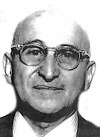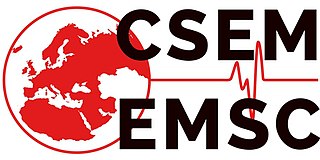
An earthquake is the shaking of the surface of the Earth resulting from a sudden release of energy in the Earth's lithosphere that creates seismic waves. Earthquakes can range in intensity, from those that are so weak that they cannot be felt, to those violent enough to propel objects and people into the air, damage critical infrastructure, and wreak destruction across entire cities. The seismic activity of an area is the frequency, type, and size of earthquakes experienced over a particular time. The seismicity at a particular location in the Earth is the average rate of seismic energy release per unit volume. The word tremor is also used for non-earthquake seismic rumbling.
The modified Mercalli intensity scale, developed from Giuseppe Mercalli's Mercalli intensity scale of 1902, is a seismic intensity scale used for measuring the intensity of shaking produced by an earthquake. It measures the effects of an earthquake at a given location, distinguished from the earthquake's inherent force or strength as measured by seismic magnitude scales. While shaking is caused by the seismic energy released by an earthquake, earthquakes differ in how much of their energy is radiated as seismic waves. Deeper earthquakes also have less interaction with the surface, and their energy is spread out across a larger volume. Shaking intensity is localized, generally diminishing with distance from the earthquake's epicenter, but can be amplified in sedimentary basins and certain kinds of unconsolidated soils.

Seismology is the scientific study of earthquakes and the propagation of elastic waves through the Earth or other planetary bodies. It also includes studies of earthquake environmental effects such as tsunamis as well as diverse seismic sources such as volcanic, tectonic, glacial, fluvial, oceanic, atmospheric, and artificial processes such as explosions. A related field that uses geology to infer information regarding past earthquakes is paleoseismology. A recording of Earth motion as a function of time is called a seismogram. A seismologist is a scientist who does research in seismology.

Beno Gutenberg was a German-American seismologist who made several important contributions to the science. He was a colleague and mentor of Charles Francis Richter at the California Institute of Technology and Richter's collaborator in developing the Richter magnitude scale for measuring an earthquake's magnitude.

Bruce Alan Bolt was an Australian-born American seismologist and a professor of earth and planetary science at the University of California, Berkeley. Professor Bolt was known as a pioneer of engineering seismology. He served for 15 years on the California Seismic Safety Commission leading public debate on earthquake safety in that state, and acted as a consultant on major projects throughout the world. As well, Bolt published a number of popular and technical books on seismology.

The Indian subcontinent has a history of devastating earthquakes. The major reason for the high frequency and intensity of the earthquakes is that the Indian plate is driving into Asia at a rate of approximately 47 mm/year. Geographical statistics of India show that almost 58% of the land is vulnerable to earthquakes. A World Bank and United Nations report shows estimates that around 200 million city dwellers in India will be exposed to storms and earthquakes by 2050. The latest version of seismic zoning map of India given in the earthquake resistant design code of India [IS 1893 2002] assigns four levels of seismicity for India in terms of zone factors. In other words, the earthquake zoning map of India divides India into 4 seismic zones unlike its previous version, which consisted of five or six zones for the country. According to the present zoning map, Zone 5 expects the highest level of seismicity whereas Zone 2 is associated with the lowest level of seismicity.

Lucile M. Jones is a seismologist and public voice for earthquake science and earthquake safety in California. One of the foremost and trusted public authorities on earthquakes, Jones is viewed by many in Southern California as the "seismologist-next-door," who is frequently called up on to provide information on recent earthquakes.

An earthquake measuring 8.0 Mw struck Santiago, Chile, on 3 March 1985, killing 177 people and injuring about 2,575 others. This earthquake was being felt between the northern Antofagasta Region and the southern Los Lagos Region. It was felt with a maximum intensity of VIII on the Mercalli intensity scale.

The International Seismological Centre (ISC) is a non-governmental, nonprofit organisation charged with the final collection, definitive analysis and publication of global seismicity. The ISC was formed in 1964 as an international organisation independent of national governments that would carry on the work of the International Seismological Summary in collecting and analyzing seismic data from around the world, and particularly to handle increased flow of data from the World-Wide Standard Seismograph Network (WWSSN), also established that year. The ISC considers its prime task to be the collection and re-analysis of all available earthquake seismic date in order to produce definitive data on earthquakes. The ISC's catalog is considered "the most complete and authoritative final depository of global earthquake parameter data."

Alexis Perrey (1807–1882) was a historical French seismologist and compiler of earthquake catalogs. He is considered a pioneer in this area, having published a paper on earthquakes in Algeria as early as 1848, in the journal Mémoires de l'Académie des Sciences, Arts et Belles-Lettres de Dijon. He continued to post annual observations on Algerian earthquakes until 1871.

The Seismological Society of America (SSA) is an international scientific society devoted to the advancement of seismology and the understanding of earthquakes for the benefit of society. Founded in 1906, the society has members throughout the world representing seismologists and other geophysicists, geologists, engineers, insurers, and policy-makers in preparedness and safety.

Weston Observatory is a geophysical research laboratory of the Department of Earth and Environmental Sciences at Boston College. The Observatory is located in the town of Weston, Massachusetts, about 13 miles (21 km) west of downtown Boston.
Harry Oscar Wood (1879–1958) was an American seismologist who made several significant contributions in the field of seismology in the early twentieth-century. Following the 1906 earthquake in San Francisco, California, Wood expanded his background of geology and mineralogy and his career took a change of direction into the field of seismology. In the 1920s he co-developed the torsion seismometer, a device tuned to detect short-period seismic waves that are associated with local earthquakes. In 1931 Wood, along with another seismologist, redeveloped and updated the Mercalli intensity scale, a seismic intensity scale that is still in use as a primary means of rating an earthquake's effects.

The European-Mediterranean Seismological Centre is an international, non-governmental and not-for-profit organisation.

The National Seismological Center of the University of Chile is part of the Department of Physical and Mathematical Sciences at the University of Chile. The center collects information about seismic activity in Chile and delivers it to the National Office of Emergency at the Ministry of the Interior (ONEMI) and the Hydrographic and Oceanographic Service of the Chilean Navy (SHOA). The current director of the CSN is Sergio Barrientos Parra. The National Seismological Center is housed by the Department of Geophysics (DGF).

Republican Seismic Survey Center– (RSSC) Republican Seismic Survey Center is the main organization, involved in the research and study of earthquakes on the territory of Azerbaijan Republic. Seismological, geophysical, geochemical and geodynamic complex researches are conducted in the Center.
The National Centre for Seismology (NCS) is an office of India's Ministry of Earth Sciences. The office monitors earthquakes and conducts seismological research. Specifically, it provides earthquake surveillance and hazard reports to governmental agencies. It consists of various divisions:
Seismic intensity scales categorize the intensity or severity of ground shaking (quaking) at a given location, such as resulting from an earthquake. They are distinguished from seismic magnitude scales, which measure the magnitude or overall strength of an earthquake, which may, or perhaps may not, cause perceptible shaking.
Michel Campillo is a French seismologist and geophysicist who is currently a professor at Grenoble Alpes University.













